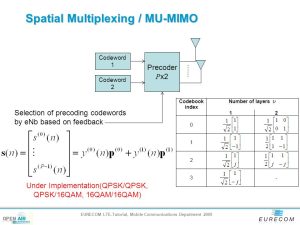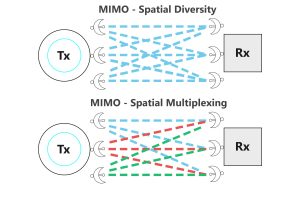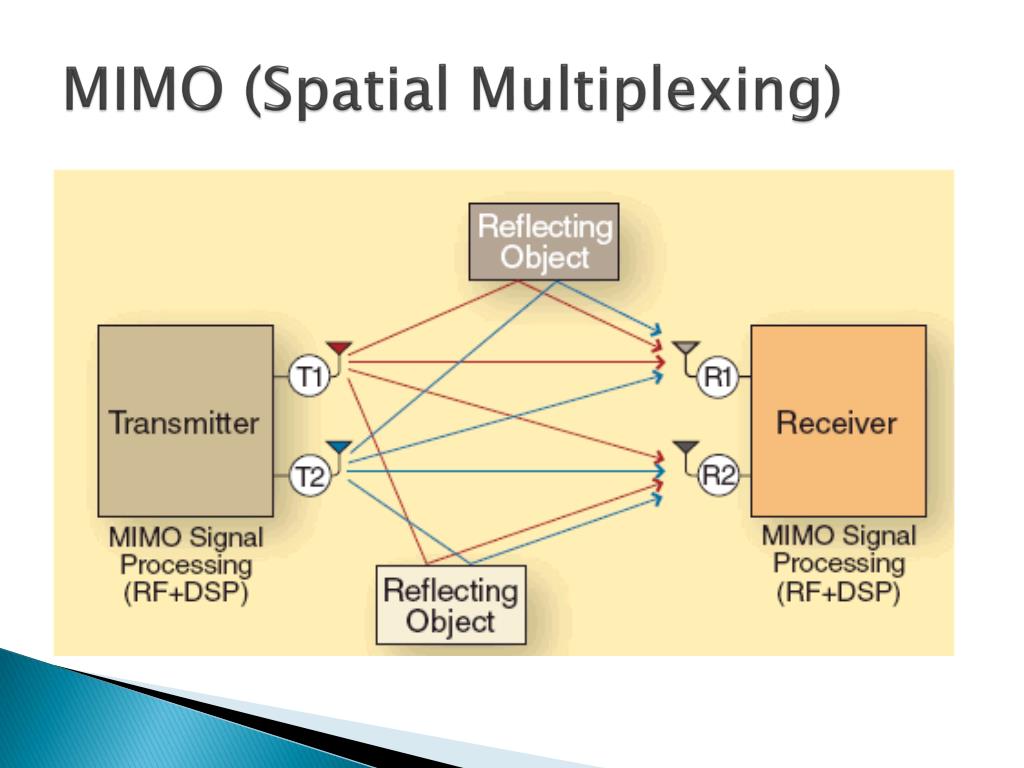MIMO systems have been a game-changer in the realm of wireless communication, captivating researchers and users alike. By employing multiple antennas, MIMO has managed to amplify signal quality while boosting data rates – a feat previously unattainable. The technology’s pièce de résistance is spatial multiplexing which facilitates concurrent transmission of several data streams via identical frequency bands. This technique surges throughput, augmenting the performance of wireless networks as a whole.

But wait – there’s more! Beamforming is another crucial aspect of MIMO systems that cannot be overlooked. It employs signal processing techniques to focus radio signals in specific directions and improve their strength while reducing interference. When combined with antenna diversity, beamforming can considerably enhance the quality of signals even in environments replete with obstacles like urban areas or congested events.
The latest addition to the MIMO family is massive MIMO which takes things up several notches by scaling up both antennas and radio streams; this results in increased capacity and coverage area without compromising on performance or reliability even when catering to large numbers of users simultaneously.
The advantages bestowed upon networks by MIMO spatial multiplexing are too numerous to count; it has transformed wireless communication into an efficient medium for transmitting data across different devices while maintaining high-quality connections.
Spatial Multiplexing: Maximizing Data Rate and Throughput with MIMO Technology
Contents
- 1 Spatial Multiplexing: Maximizing Data Rate and Throughput with MIMO Technology
- 2 Beamforming and Antenna Diversity: Improving Signal Quality in MIMO Systems
- 3 Massive MIMO: Scaling Up with Multiple Antennas and Radio Streams
- 4 The Advantages of MIMO Spatial Multiplexing in Networks
- 5 Transmitting and Receiving with Multiple Antennas: The Benefits of MIMO Systems
- 6 Achieving High Data Rates with MIMO Technology and Space-Time Block Coding
- 7 The Importance of Antenna Elements and Signal Processing in MIMO-Based Wireless Communication.
MIMO spatial multiplexing – a mind-boggling technology that employs numerous antennas to transmit and receive data simultaneously. Its magic lies in exploiting the labyrinthine path radio waves travel, where signals ricochet off surfaces before reaching their intended receiver. By harnessing this complex phenomenon, MIMO spatial multiplexing significantly bolsters wireless communication systems by increasing data rate and throughput.

To achieve such lofty goals with MIMO technology, it is imperative to utilize multiple antennas like beamforming and antenna diversity. The former enables streamlining of signals in a specific direction while the latter enhances signal quality by mitigating interference caused by fading or noise. Working hand-in-hand with MIMO spatial multiplexing, these techniques help provide 5G networks with better coverage and higher capacity.
Spatial multiplexing empowers simultaneous transmission of more than one information stream over the same frequency band. This implies that MIMO spatial multiplexing can achieve faster data rates sans requiring additional bandwidth. Additionally, utilizing multiple radio streams improves reliability since it provides redundancy in case one path fails.
In essence, MIMO spatial multiplexing is an effective way to maximize data rate and throughput through its use of advanced signal processing techniques like beamforming and antenna diversity alongside multiple antennas’ utilization. It paves the way for faster speeds, greater capacity, improved coverage, and enhanced reliability for 5G networks – benefits that will only grow as we continue advancing antenna elements and other technologies related to wireless communication systems!
Beamforming and Antenna Diversity: Improving Signal Quality in MIMO Systems
The techniques of beamforming and antenna diversity are integral to the enhancement of signal quality in MIMO systems. Beamforming involves a puzzling process whereby transmission signals are directed with precision towards specific receive antennas, resulting in amplified overall signal strength and reduced interference from other sources. Antenna diversity, on the other hand, is an explosive technique that employs multiple antennas at both the transmitter and receiver ends – this serves to increase signal quality by minimizing multipath fading.
It’s mind-bending just how much throughput can be achieved through utilizing beamforming within a MIMO system – data rates can be improved significantly by directing more energy towards those sweet-spot receive antennas with better channel conditions. And get this: not only does beamforming enhance throughput but it also reduces pesky interference from external sources lurking in the wireless environment.
Massive MIMO systems take advantage of antenna diversity with an awe-inspiring display of multiple transmit and receive antennas operating simultaneously. This approach leads to higher levels of spatial multiplexing which ultimately translates into greater data rates for users; furthermore, such use mitigates issues caused by frustrating fades induced by vexatious multipath propagation.
In conclusion (if there even is one!), we must acknowledge that without both beamforming and antenna diversity, achieving optimal signal quality within MIMO systems would be like solving a Rubik’s Cube blindfolded – impossible! Utilizing these impactful techniques alongside multiple transmit/receive antennas allows us to achieve high-throughput while avoiding bothersome interference from external factors – making for reliable communication performance when high data rates are crucial.
Massive MIMO: Scaling Up with Multiple Antennas and Radio Streams
The world of wireless communication is evolving at a rapid pace, and the demand for higher data rates and spectral efficiency has left many scratching their heads. Enter Massive MIMO technology – a solution that may just be the answer to our technological woes.
With its multiple antennas at both the transmitter and receiver, Massive MIMO can support an impressive amount of data streams simultaneously. This means we can increase bandwidth like never before. But what makes it so different from Single Input Single Output (SISO) systems? Well, unlike SISO which only uses one antenna at each end, MIMO employs multiple antennas for spatial multiplexing across separate channels between transmitter and receiver.
But wait! There’s more! With Massive MIMO, we take this concept even further by scaling up with even more transmit and receive antennas. This allows us to transmit even more data streams simultaneously than ever before! Plus, space-time block coding techniques are used to improve reliability by transmitting redundant information across all available antennas.
Utilizing advanced antenna tech along with signal processing techniques such as beamforming and antenna diversity takes performance levels beyond traditional LTE networks. The ability to maintain high data rates while supporting an exceptional number of simultaneous users gives us hope for future wireless communication systems thanks to Massive MIMO technology!
The Advantages of MIMO Spatial Multiplexing in Networks
The technology of multiple input multiple output (MIMO) spatial multiplexing has caused quite a stir in the world of wireless communication. It has completely transformed the way we transmit data by utilizing numerous antennas at both ends to enhance signal quality and increase data rates. One of its most noteworthy features is that it can support numerous users simultaneously.
By exploiting spatial degree of freedom, MIMO systems can send independent data streams over the same frequency band. This means that different users can receive their own unique signals without any interference, resulting in better spectral efficiency and higher throughput. In addition to this, diversity techniques such as beamforming and antenna diversity further improve signal quality by mitigating fading effects caused by noise or interference.
In downlink transmission, MIMO technology allows for four simultaneous streams or more from one antenna system while uplink transmission also benefits from receiving data through multiple antenna elements. With these capabilities, 5G networks are expected to utilize MIMO spatial multiplexing extensively across various industries and applications.
Overall, MIMO spatial multiplexing provides significant advantages for wireless communication systems by allowing simultaneous transmission of independent signals while improving SNR and reducing interference. As our demand for high-speed connectivity increases across diverse environments, it is clear that multiple antenna technology will play an important role in meeting these needs efficiently and effectively.\n
Transmitting and Receiving with Multiple Antennas: The Benefits of MIMO Systems
The wireless communication landscape has undergone a seismic shift with the introduction of MIMO technology. By utilizing multiple antennas at both ends of the transmission, MIMO-based systems have elevated signal quality, data rates and throughput to unprecedented heights.
But what makes MIMO truly remarkable is its ability to achieve multiplexing gain through spatial streams. This mystical technique enables simultaneous transmission of numerous data streams via different antenna paths, resulting in an exponential increase in bandwidth utilization. The secret sauce lies in multiple antenna diversity that operates seamlessly between transmitter and receiver.
But wait, there’s more! Another advantage of MIMO is its prowess in improving signal-to-noise ratio (SNR) by exploiting receiver diversity. With innovative techniques like beamforming and antenna selection commonplace among many MIMO systems, SNR enhancement becomes second nature. And if you thought that was impressive enough already, brace yourself for massive MIMO systems – they’re on another level entirely!
So all-in-all, it’s clear that deploying multiple antennas for transmitting and receiving offers several benefits in wireless communication networks. Employing features like spatial streams, transmit diversity or receiver diversity alongside game-changing innovations such as beamforming or massive-MIMOs assures high-speed connectivity without any additional infrastructure investment requirements whatsoever! Whether your network is big or small – never underestimate the power of multiple antennas on both sides: transmitter AND receiver- it ensures maximum efficiency every time!
Achieving High Data Rates with MIMO Technology and Space-Time Block Coding
Spatial multiplexing, an innovative technique employed in MIMO systems, has the ability to leave one perplexed with its unique ability to transmit and receive multiple data streams at the same time. This novel approach is a stark contrast to traditional single-antenna systems that can only manage one stream of data at a time, leaving users frustrated and wanting for more.
The secret sauce behind spatial multiplexing lies in its use of multiple antenna elements in an antenna array that creates different patterns for each stream – talk about burstiness! The number of antennas used directly impacts the system’s capability to send and receive more information simultaneously. For instance, if there are four transmit antennas operating at identical frequency and phase, then four streams can be achieved resulting in transmitting four times as much information compared to single-antenna transmission!
To make things even better (if possible), space-time block coding (STBC) is brought into play for improved efficiency. STBC combines signals from multiple transmit antennas into one signal that gets sent through all available antennas concurrently! It helps reduce pesky errors caused by fading or interference while also enhancing overall transmission quality.
By utilizing spatial multiplexing and STBC techniques alongside several other transmitters, MIMO technology takes wireless communication speeds up a notch – something previously unattainable with archaic methods. Modern wireless networks rely heavily on this innovation; it provides faster transfer speeds over greater distances without compromising on quality or reliability – making it indispensable today.
The Importance of Antenna Elements and Signal Processing in MIMO-Based Wireless Communication.
The enigmatic prowess of MIMO technology lies in its ability to transmit and receive multiple independent data streams using several sets of antennas. However, this feat requires a greater number of transmit antennas than receive antennas to achieve spatial multiplexing – which can result in up to four times as much data being transmitted compared to a system with only one antenna.
But perplexity arises when it comes time for the receiver to recover the original data. Signal processing techniques such as beamforming and space-time block coding must be employed, allowing each individual stream to be decoded either separately or in some combination; ultimately resulting in the desired output. Indeed, these techniques are measured by their effectiveness in terms of lower error rates and increased throughput.
Moreover, MIMO technology provides antenna diversity – improving signal quality by reducing interference caused by fading channels. It is vital that all antennas work together seamlessly by maintaining equal functionality. Thus, understanding how antenna elements and signal processing coalesce is crucial for optimizing performance and achieving optimal results with MIMO-based wireless communication systems.


